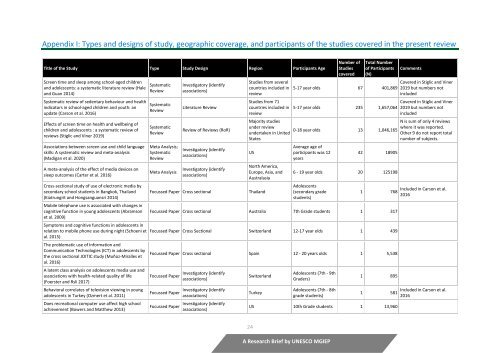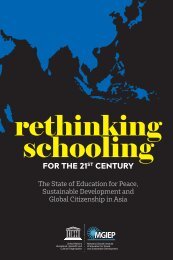Screen Time and Learner Well-being
The Debate, the Evidence and Directions for Future
The Debate, the Evidence and Directions for Future
You also want an ePaper? Increase the reach of your titles
YUMPU automatically turns print PDFs into web optimized ePapers that Google loves.
Appendix I: Types <strong>and</strong> designs of study, geographic coverage, <strong>and</strong> participants of the studies covered in the present review<br />
Title of the Study Type Study Design Region Participants Age<br />
<strong>Screen</strong> time <strong>and</strong> sleep among school-aged children<br />
<strong>and</strong> adolescents: a systematic literature review (Hale<br />
<strong>and</strong> Guan 2014)<br />
Systematic review of sedentary behaviour <strong>and</strong> health<br />
indicators in school-aged children <strong>and</strong> youth: an<br />
update (Carson et al. 2016)<br />
Effects of screen time on health <strong>and</strong> well<strong>being</strong> of<br />
children <strong>and</strong> adolescents : a systematic review of<br />
reviews (Stiglic <strong>and</strong> Viner 2019)<br />
Associations between screen use <strong>and</strong> child language<br />
skills: A systematic review <strong>and</strong> meta-analysis<br />
(Madigan et al. 2020)<br />
A meta-analysis of the effect of media devices on<br />
sleep outcomes (Carter et al. 2016)<br />
Cross-sectional study of use of electronic media by<br />
secondary school students in Bangkok, Thail<strong>and</strong><br />
(Kiatrungrit <strong>and</strong> Hongsanguansri 2014)<br />
Mobile telephone use is associated with changes in<br />
cognitive function in young adolescents (Abramson<br />
et al. 2009)<br />
Symptoms <strong>and</strong> cognitive functions in adolescents in<br />
relation to mobile phone use during night (Schoeni et<br />
al. 2015)<br />
The problematic use of Information <strong>and</strong><br />
Communication Technologies (ICT) in adolescents by<br />
the cross sectional JOITIC study (Muñoz-Miralles et<br />
al. 2016)<br />
A latent class analysis on adolescents media use <strong>and</strong><br />
associations with health-related quality of life<br />
(Foerster <strong>and</strong> Rsli 2017)<br />
Behavioral correlates of television viewing in young<br />
adolescents in Turkey (Ozmert et al. 2011)<br />
Does recreational computer use affect high school<br />
achievement (Bowers <strong>and</strong> Matthew 2013)<br />
Systematic<br />
Review<br />
Systematic<br />
Review<br />
Systematic<br />
Review<br />
Meta Analysis;<br />
Systematic<br />
Review<br />
Meta Analysis<br />
Investigatory (identify<br />
associations)<br />
Literature Review<br />
Review of Reviews (RoR)<br />
Investigatory (identify<br />
associations)<br />
Investigatory (identify<br />
associations)<br />
Focussed Paper Cross sectional<br />
Studies from several<br />
countries included in<br />
review<br />
Studies from 71<br />
countries included in<br />
review<br />
Majority studies<br />
under review<br />
undertaken in United<br />
States<br />
US<br />
North America,<br />
Europe, Asia, <strong>and</strong><br />
Australasia<br />
Thail<strong>and</strong><br />
Number of<br />
Studies<br />
covered<br />
Total Number<br />
of Participants<br />
(N)<br />
5-17 year olds 67 401,869<br />
5-17 year olds 235 1,657,064<br />
0-18 year olds 13 1,046,165<br />
Average age of<br />
participants was 12<br />
years<br />
42 18905<br />
6 - 19 year olds 20 125198<br />
Adolescents<br />
(secondary grade<br />
students)<br />
1 768<br />
Focussed Paper Cross sectional Australia 7th Grade students 1 317<br />
Focussed Paper Cross Sectional Switzerl<strong>and</strong> 12-17 year olds 1 439<br />
Focussed Paper Cross sectional Spain 12 - 20 years olds 1 5,538<br />
Focussed Paper<br />
Focussed Paper<br />
Focussed Paper<br />
Investigatory (identify<br />
associations)<br />
Investigatory (identify<br />
associations)<br />
Investigatory (identify<br />
associations)<br />
Switzerl<strong>and</strong><br />
Turkey<br />
Adolescents (7th - 9th<br />
Graders)<br />
Adolescents (7th - 8th<br />
grade students)<br />
1 895<br />
1 581<br />
US 10th Grade students 1 13,960<br />
Comments<br />
Covered in Stiglic <strong>and</strong> Viner<br />
2019 but numbers not<br />
included<br />
Covered in Stiglic <strong>and</strong> Viner<br />
2019 but numbers not<br />
included<br />
N is sum of only 4 reviews<br />
where it was reported.<br />
Other 9 do not report total<br />
number of subjects.<br />
Included in Carson et al.<br />
2016<br />
Included in Carson et al.<br />
2016<br />
24<br />
A Research Brief by UNESCO MGIEP

















